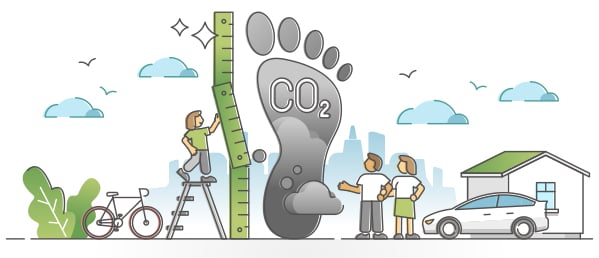By Jackson Pentz,
Sustainability Analyst
Sustainable Investment Group (SIG)

Whether you enjoy reading in a Brooklyn studio, or catching waves in San Diego, skiing in the Rockies, or gaming with your friends, everyone relies on the environment to support their favorite activities. Yet, with the rapid pace of modern life, many Americans are left to wonder how they can fit time for sustainability into their busy schedules. Now more than ever, it is important to find time effective ways of supporting Earth’s natural systems. Luckily, SIG has you covered. Here are a few things you can do in ten minutes or less to help reduce your carbon footprint.
1. Store Reusable Grocery Bags in Your Car Door
 We have all been there, the moment of shame when you push your cart into the checkout line and realize that you left your reusable bags at home, or even worse, in the car. To avoid choosing between paper and plastic, switch to storing your reusable bags in the door or center console of your car. The next time you go to collect your keys, wallet, and phone before frolicking into Target you will be more likely to see and remember your conscience cleaning reusable bags.
We have all been there, the moment of shame when you push your cart into the checkout line and realize that you left your reusable bags at home, or even worse, in the car. To avoid choosing between paper and plastic, switch to storing your reusable bags in the door or center console of your car. The next time you go to collect your keys, wallet, and phone before frolicking into Target you will be more likely to see and remember your conscience cleaning reusable bags.
2. Avoid Rush Shipping When Possible
Online shopping is an amazing convenience of modern life. The ability to purchase items from all over the world and have them delivered to your doorstep with just a couple clicks (and some far too familiar credit card information) was no more than science fiction just 20 years ago. But the incredible number of goods shipped to consumers everyday utilizes enormous amounts of natural resources. Rushed or expedited shipping adds to these demands as more miles logged by planes, trains, and trucks are needed to make goods arrive on time. The next time you buy online, ask yourself whether you need your item overnight, or if you can wait a little longer to save money, resources, and CO2 emissions.
3. Use a Small Plate
If you are a fan of life hacks, I suggest trying this one out. Food waste is the main contributor to landfills in the United States. To help reduce the amount of food you throw away, try using a small plate for meals. Small plates trick your brain into thinking you have eaten more than you have, since we are used to measuring consumption by the number of plates rather than by volume. This is a trick buffets have used for years to make customers feel fuller faster, and it might just help you save money at mealtime.
4. Put a Travel Coffee Mug in the Car
Coffee is the most widely consumed caffeinated beverage in the United States. This national caffeine dependency is a huge contributor to Americans’ use of 50 billion disposable cups every year. Keeping a clean travel mug in the car allows you to reduce your contribution to landfills, and take advantage of discounts major chains like Starbucks, Dunkin, and 7-eleven offer for bringing your own mug. Learn about Starbuck’s cup discount here.
Learn about the problem with disposable cups here.
5. Skip the Utensils When Ordering Delivery
Like online shopping, food delivery options such as Ubereats, Doordash, and Grub Hub, can be remarkably convenient. Unfortunately, when your food arrives, how often do you dig into pizza, wings, or Chinese food with your own silverware, leaving a bag of napkins, wrappers, and Styrofoam for the trash? It might happen more than you think. Forbes estimates 40 billion plastic utensils are discarded unused every year. An easy alternative to save waste is to leave a message on your order to exclude utensils, napkins, or any other unnecessary paper or plastic materials. Leaving the message takes seconds, and delivery always tastes better when there is less cleanup.
Learn more here.
6. Switch to Online Bill Pay and Email Receipts.

In 2019, the Washington Post reported that producing paper receipts consumes the equivalent of 3 million trees each year. While tough on the environment, paper receipts are also difficult to keep track of, and easily overrun purses and wallets. To avoid this mess and save the trees, consider switching your billing preference to email, or opting for a digital receipt from retailers. Many banks and credit cards will let you pay your bills completely online, a timesaving, green alternative to sorting through piles of paper receipts.
Learn more here.
7. Donate Unused Clothing
High resource demands, international transportation, and harmful chemical runoff are all trademarks of the fashion industry’s environmental impact. Sadly, a 2020 study reported by Consumption and Environment showed that the average American only wears about 45% of the clothes he or she owns. If this sounds like you, try collecting some clothes you have not worn in a while to donate to a local Goodwill or sell in a consignment shop. Recycling clothing is a heartwarming way to reduce your carbon footprint while helping those in need.
9. Reuse Water for Plants

Having house plants is a timeless way of improving the mood and aesthetics of a room, while bringing a piece of nature indoors. If you want to double down on your sustainable décor, try watering your
plants with water used for other household activities. Plants appreciate water from a dehumidifier or warm-up water from a shower just as much as from the tap. The EPA estimates that the average American family uses 300 gallons of water per day, almost all of which is used only once. Despite how it may seem, water is a finite resource, and developing ways to repurpose non-potable water not only reduces stress on water management systems but can also lower your water bill at the end of the month.
Learn more here.
10. Calculate your Carbon Footprint with the Global Footprint Network

The saying goes, “you can’t improve what you don’t measure.” This holds true even for your environmental impact. If you are curious, you can measure your carbon footprint at home with the free online calculator from the Global Footprint Network. With just a few sliding-scale questions about your habits, the calculator tells you how many Earths we would need if everyone on the planet lived the same way you do and further breaks down your carbon footprint into sections such as transportation and diet. Measuring consumption in planet sized units is a powerful visualization of the price the environment pays for our everyday decisions and might help convince you to make a few changes to reduce your carbon footprint. Remember, we only have one Earth, there is no planet b.
Calculate your carbon footprint, here.
Related articles:
Circular Fashion Instead of Fast Fashion
© 2021 Sustainable Investment Group (SIG). All rights reserved.



